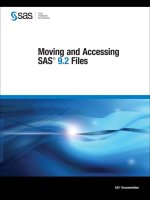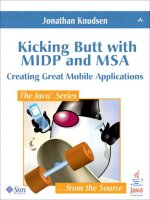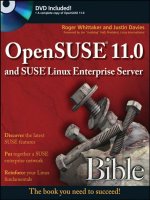Prentice hall kicking butt with MIDP and MSA creating great mobile applications jan 2008 ISBN 0321463420 pdf
Bạn đang xem bản rút gọn của tài liệu. Xem và tải ngay bản đầy đủ của tài liệu tại đây (3.2 MB, 429 trang )
Kicking Butt with
MIDP and MSA
The Java™ Series
Ken Arnold, James Gosling, David Holmes
The Java™ Programming Language, Fourth Edition
Eric Jendrock, Jennifer Ball
The Java™ EE 5 Tutorial, Third Edition
Joshua Bloch
Effective Java™ Programming Language Guide
Jonni Kanerva
The Java™ FAQ
Stephanie Bodoff, Dale Green, Kim Haase, Eric Jendrock
The J2EE™ Tutorial, Second Edition
Doug Lea
Concurrent Programming in Java™, Second Edition:
Design Principles and Patterns
Mary Campione, Kathy Walrath, Alison Huml
The Java™ Tutorial, Third Edition: A Short Course on
the Basics
Mary Campione, Kathy Walrath, Alison Huml, The
Tutorial Team
The Java™ Tutorial Continued: The Rest of the JDK™
Patrick Chan
The Java™ Developers Almanac 1.4, Volume 1
Patrick Chan
The Java™ Developers Almanac 1.4, Volume 2
Patrick Chan, Rosanna Lee
The Java™ Class Libraries, Second Edition, Volume 2:
java.applet, java.awt, java.beans
Patrick Chan, Rosanna Lee, Doug Kramer
The Java Class Libraries, Second Edition, Volume 1:
Supplement for the Java™ 2 Platform, Standard Edition,
v1.2
™
Kirk Chen, Li Gong
Programming Open Service Gateways with Java™
Embedded Server
Zhiqun Chen
Java Card™ Technology for Smart Cards: Architecture
and Programmer’s Guide
Maydene Fisher, Jon Ellis, Jonathan Bruce
JDBC™ API Tutorial and Reference, Third Edition
Eric Freeman, Susanne Hupfer, Ken Arnold
JavaSpaces™ Principles, Patterns, and Practice
Li Gong, Gary Ellison, Mary Dageforde
Inside Java™ 2 Platform Security, Second Edition:
Architecture, API Design, and Implementation
James Gosling, Bill Joy, Guy Steele, Gilad Bracha
The Java™ Language Specification, Third Edition
Mark Hapner, Rich Burridge, Rahul Sharma, Joseph
Fialli, Kim Haase
Java™ Message Service API Tutorial and Reference:
Messaging for the J2EE™ Platform
Rosanna Lee, Scott Seligman
JNDI API Tutorial and Reference: Building DirectoryEnabled Java™ Applications
Sheng Liang
The Java™ Native Interface: Programmer’s Guide and
Specification
Tim Lindholm, Frank Yellin
The Java™ Virtual Machine Specification, Second Edition
Roger Riggs, Antero Taivalsaari, Jim Van Peursem, Jyri
Huopaniemi, Mark Patel, Aleksi Uotila
Programming Wireless Devices with the Java™ 2
Platform, Micro Edition, Second Edition
Rahul Sharma, Beth Stearns, Tony Ng
J2EE™ Connector Architecture and Enterprise
Application Integration
Inderjeet Singh, Beth Stearns, Mark Johnson, Enterprise
Team
Designing Enterprise Applications with the J2EE™
Platform, Second Edition
Inderjeet Singh, Sean Brydon, Greg Murray, Vijay
Ramachandran, Thierry Violleau, Beth Stearns
Designing Web Services with the J2EE™ 1.4 Platform:
JAX-RPC, SOAP, and XML Technologies
Kathy Walrath, Mary Campione, Alison Huml, Sharon
Zakhour
The JFC Swing Tutorial, Second Edition: A Guide to
Constructing GUIs
Steve Wilson, Jeff Kesselman
Java™ Platform Performance: Strategies and Tactics
Sharon Zakhour, Scott Hommel, Jacob Royal,
Isaac Rabinovitch, Tom Risser, Mark Hoeber
The Java™ Tutorial, Fourth Edition: A Short Course
on the Basics
Kicking Butt with
MIDP and MSA
Creating Great
Mobile Applications
Jonathan Knudsen
Boston • San Francisco • New York • Toronto • Montreal
London • Munich • Paris • Madrid
Capetown • Sydney • Tokyo • Singapore • Mexico City
Many of the designations used by manufacturers and sellers to distinguish their products are claimed as trademarks. Where those designations appear in this book, and the publisher was aware of a trademark claim, the designations have been printed with initial capital letters or in all capitals.
Sun Microsystems, Inc. has intellectual property rights relating to implementations of the technology described in this publication. In
particular, and without limitation, these intellectual property rights may include one or more U.S. patents, foreign patents, or pending
applications.
Sun, Sun Microsystems, the Sun logo, J2ME, J2EE, Java Card, and all Sun and Java based trademarks and logos are trademarks or registered trademarks of Sun Microsystems, Inc., in the United States and other countries. UNIX is a registered trademark in the United States
and other countries, exclusively licensed through X/Open Company, Ltd. THIS PUBLICATION IS PROVIDED “AS IS” WITHOUT
WARRANTY OF ANY KIND, EITHER EXPRESS OR IMPLIED, INCLUDING, BUT NOT LIMITED TO, THE IMPLIED WARRANTIES OF MERCHANTABILITY, FITNESS FOR A PARTICULAR PURPOSE, OR NON-INFRINGEMENT. THIS PUBLICATION COULD INCLUDE TECHNICAL INACCURACIES OR TYPOGRAPHICAL ERRORS. CHANGES ARE PERIODICALLY
ADDED TO THE INFORMATION HEREIN; THESE CHANGES WILL BE INCORPORATED IN NEW EDITIONS OF THE PUBLICATION. SUN MICROSYSTEMS, INC. MAY MAKE IMPROVEMENTS AND/OR CHANGES IN THE PRODUCT(S) AND/OR
THE PROGRAM(S) DESCRIBED IN THIS PUBLICATION AT ANY TIME.
The author and publisher have taken care in the preparation of this book, but make no expressed or implied warranty of any kind and
assume no responsibility for errors or omissions. No liability is assumed for incidental or consequential damages in connection with or
arising out of the use of the information or programs contained herein.
The publisher offers excellent discounts on this book when ordered in quantity for bulk purchases or special sales, which may include
electronic versions and/or custom covers and content particular to your business, training goals, marketing focus, and branding interests. For more information, please contact: U.S. Corporate and Government Sales, (800) 382-3419,
For sales outside the United States please contact: International Sales,
Visit us on the Web: www.awprofessional.com
Library of Congress Cataloging-in-Publication Data
Knudsen, Jonathan.
Kicking butt with MIDP and MSA : creating great mobile applications / Jonathan Knudsen.
p. cm.
Includes index.
ISBN 0-321-46342-0 (pbk. : alk. paper)
1. Mobile computing. 2. Application software—Development. 3. Smartphones. 4. Pocket computers.
I. Title. II. Title: Kicking butt with Mobile Information Device Profile and Mobile Service Architecture.
QA76.59.K657 2008
004.16—dc22
2007045477
Copyright © 2008 Sun Microsystems, Inc.
4150 Network Circle, Santa Clara, California 95054 U.S.A.
All rights reserved.
Printed in the United States of America. This publication is protected by copyright, and permission must be obtained from the publisher
prior to any prohibited reproduction, storage in a retrieval system, or transmission in any form or by any means, electronic, mechanical,
photocopying, recording, or likewise. For information regarding permissions, write to: Pearson Education, Inc., Rights and Contracts
Department, 501 Boylston Street, Suite 900, Boston, MA 02116, Fax: (617) 671-3447.
ISBN 13: 978-0-321-46342-5
ISBN 10:
0-321-46342-0
Text printed in the United States on recycled paper at RR Donnelley in Crawfordsville, Indiana.
First printing, December 2007
For Kristen, my true love
This page intentionally left blank
Contents
Foreword . . . . . . . . . . . . . . . . . . . . . . . . . . . . . . . . . . . . . . . . . . . . xvii
Preface . . . . . . . . . . . . . . . . . . . . . . . . . . . . . . . . . . . . . . . . . . . . . xix
Acknowledgments . . . . . . . . . . . . . . . . . . . . . . . . . . . . . . . . . . . . xxi
About the Author . . . . . . . . . . . . . . . . . . . . . . . . . . . . . . . . . . . . . xxiii
SECTION I
GETTING STARTED . . . . . . . . . . . . . . . . . . . . . . . . . . 1
Chapter 1
Overview . . . . . . . . . . . . . . . . . . . . . . . . . . . . . . . . . . 3
1.1
1.2
1.3
1.4
1.5
Not Plastics, but Wireless
MIDP, the Heart and Soul of Mobile Java Technology
The First Umbrella: JTWI
A Bigger Umbrella: MSA
Understanding MSA APIs
1.5.1 Basic MIDP Platform
1.5.2 Advanced Networking
1.5.3 Multimedia
1.5.4 Advanced Graphics
1.5.5 Security and Transactions
1.5.6 Location
1.5.7 Advanced Application Invocation
1.5.8 Advanced Application Services
1.6 Looking beyond MSA 1.0
1.7 What about JavaFX Mobile?
1.8 Summary
3
4
5
6
7
7
7
8
8
8
8
9
9
9
10
10
vii
viii
CONTENTS
Chapter 2
Tools . . . . . . . . . . . . . . . . . . . . . . . . . . . . . . . . . . . . . 11
2.1
2.2
2.3
2.4
2.5
2.6
2.7
2.8
2.9
2.10
2.11
Chapter 3
11
13
13
14
15
16
17
17
18
18
19
Quick Start . . . . . . . . . . . . . . . . . . . . . . . . . . . . . . . . 21
3.1
3.2
3.3
3.4
3.5
Chapter 4
Sun Java Wireless Toolkit for CLDC: A Toaster Oven
NetBeans Mobility Pack: A Gourmet Kitchen
Eclipse, Too
Inside a MIDlet Suite
Building a MIDlet Suite
The Command Line: A Campfire
Preprocessors
Obfuscators
Emulators
Device Testing
Summary
Make Something That Runs
Put Something on the Screen
Give the User Something to Do
Get the Source Code Online
Summary
21
22
23
25
26
Core APIs . . . . . . . . . . . . . . . . . . . . . . . . . . . . . . . . . 27
4.1
4.2
4.3
4.4
4.5
4.6
JVM Features You Might Miss
Strings, Primitive Types, and System Methods
Threads
Using Streams for Input and Output
4.4.1 Be Clean
4.4.2 Reading Input Data Completely
Dates, Collections, and Random Numbers
Summary
28
28
29
30
30
31
32
33
SECTION II
THE LIVES OF MIDLETS . . . . . . . . . . . . . . . . . . . . . . . 35
Chapter 5
The MIDlet Habitat . . . . . . . . . . . . . . . . . . . . . . . . . . 37
5.1
5.2
5.3
The MIDlet Life Cycle
5.1.1 AMS, the MIDlet Puppeteer
5.1.2 What about That unconditional Argument?
5.1.3 MIDlets Can Control Their Destinies
Using the Browser and Making Calls
Application Properties
37
37
39
39
40
40
CONTENTS
5.4
5.5
5.6
5.7
Chapter 6
Protection Domains and Signed MIDlet Suites
Permissions
The Bottom Line on MIDlet Signing
Summary
41
42
44
45
Starting MIDlets Automatically . . . . . . . . . . . . . . . . 47
6.1
6.2
6.3
6.4
Responding to Network Connections
6.1.1 Dynamic Registration
6.1.2 Static Registration
6.1.3 Finding Incoming Connections
6.1.4 A Push Registry Example
Running a MIDlet at a Specific Time
Responding to Content
6.3.1 Invoking a Content Handler
6.3.2 Writing a Content Handler MIDlet
6.3.3 Putting It All Together
6.3.4 Static Content Handler Registration
Summary
47
48
48
49
49
54
56
57
59
64
65
66
SECTION III
USER INTERFACE . . . . . . . . . . . . . . . . . . . . . . . . . . 67
Chapter 7
Basic User Interface . . . . . . . . . . . . . . . . . . . . . . . . 69
7.1
7.2
7.3
7.4
7.5
7.6
7.7
7.8
7.9
7.10
Chapter 8
How to Show Screens
TextBox, the Runt of the Litter
Input Modes
Using Alerts for Notifications
A Very Quick Introduction to Images
Putting It Together
Good for the Old Ticker
The Whole Story on Commands
Command Placement
Summary
70
71
72
73
74
74
76
76
79
80
More User Interface . . . . . . . . . . . . . . . . . . . . . . . . 81
8.1
8.2
8.3
8.4
8.5
Lists
List Selections
Handling List Events
Three Lists in One Example
Advanced List Control
81
83
83
84
86
ix
x
CONTENTS
8.6
8.7
8.8
8.9
8.10
8.11
8.12
Using Forms
Working with Items
Gauges
Controlling Item Layout
Please Drink Form Responsibly
Item Change Events and Item Commands
Summary
86
88
89
90
92
95
98
SECTION IV GRAPHICS . . . . . . . . . . . . . . . . . . . . . . . . . . . . . . . 99
Chapter 9
Creating Custom Screens . . . . . . . . . . . . . . . . . . . 101
9.1
9.2
9.3
9.4
9.5
9.6
9.7
9.8
9.9
9.10
9.11
9.12
9.13
9.14
9.15
Chapter 10
101
102
102
105
109
111
114
116
118
119
121
124
124
127
129
Custom Items . . . . . . . . . . . . . . . . . . . . . . . . . . . . . 131
10.1
10.2
10.3
10.4
10.5
10.6
10.7
Chapter 11
Getting Information about the Display
How Painting Works
Making Colors
Drawing Lines and Shapes
Drawing Text
Measuring Text
Creating Images
Drawing Images
Keeping Resources Small
Drawing on Images
Getting Your Fingers on the Bits
Clipping
Event Handling
Controlling Command Placement
Summary
Custom Item Sizing
Painting
A Pretty Wait Indicator
Handling Events in Custom Items
Internal Traversal
An Interactive Example
Summary
131
132
132
135
136
137
142
Using the Game API . . . . . . . . . . . . . . . . . . . . . . . . 143
11.1 Tight Looping with GameCanvas
11.2 Building Scenes with Layers
11.3 Tiled Layers
143
148
149
CONTENTS
11.4
11.5
11.6
11.7
11.8
Chapter 12
151
153
153
154
158
Scalable Vector Graphics . . . . . . . . . . . . . . . . . . . 159
12.1
12.2
12.3
12.4
12.5
12.6
12.7
Chapter 13
Sprites
Detecting Collisions
Assembling a Game Scene
A Blocky Example
Summary
The Simplest Way to Show SVG Content
Working with Animated Documents
Digging into an SVG Document
Displaying an SVG Document on Your Own Canvas
Creating New SVG Elements
SVG Event Handling
Summary
160
163
166
168
171
174
178
3D Graphics . . . . . . . . . . . . . . . . . . . . . . . . . . . . . 179
13.1
13.2
13.3
13.4
Creating M3G Files
Displaying 3D Content the Easy Way
Doing It the Hard Way
Summary
179
180
184
192
SECTION V
STORAGE AND RESOURCES . . . . . . . . . . . . . . . . . 193
Chapter 14
Record Stores . . . . . . . . . . . . . . . . . . . . . . . . . . . . 195
14.1
14.2
14.3
14.4
14.5
14.6
14.7
Chapter 15
Itsy Bitsy Teenie Weenie Databases
Working with Record Stores
Manipulating Records
Making Queries
Iterating through Records
A Place to Keep Your Stuff
Summary
196
196
198
199
199
200
204
Reading and Writing Files . . . . . . . . . . . . . . . . . . . 205
15.1
15.2
15.3
15.4
15.5
15.6
The Quick Story
Working with Files and Directories
Somewhere, a Place for Us
Finding Pictures, Music, and Other Goodies
Starting from the Top
Ask for Permission
205
206
208
208
209
209
xi
xii
CONTENTS
15.7 An Example
15.8 Summary
Chapter 16
Contacts and Calendars . . . . . . . . . . . . . . . . . . . . 215
16.1 Understanding the PIM API
16.2 Working with Lists
16.2.1 Item Queries
16.2.2 String Array Fields
16.2.3 Labels
16.2.4 Categories
16.2.5 Special Methods for Contact Lists
16.2.6 Special Methods for Calendars and Appointments
16.2.7 Special Methods for To-Do Lists
16.3 Where Do Lists Come From?
16.4 Importing and Exporting
16.5 What’s Supported?
16.6 Don’t Forget Permissions
16.7 Example
16.8 Summary
Chapter 17
210
213
215
217
217
218
219
219
219
220
220
220
221
222
222
223
232
Mobile Internationalization . . . . . . . . . . . . . . . . . . 233
17.1
17.2
17.3
17.4
17.5
17.6
17.7
17.8
About Locales
Using Resources
Finding Resources
Resource Inheritance
Formatting Numbers and Dates
Sorting Strings
Take It Out for a Spin
Summary
233
234
235
237
237
239
239
244
SECTION VI
NETWORKING . . . . . . . . . . . . . . . . . . . . . . . . . . . . 245
Chapter 18
The Generic Connection Framework . . . . . . . . . . . 247
18.1
18.2
18.3
18.4
18.5
18.6
18.7
Making Connections
Clean Up
Use Threads
Image Loading via HTTP
Advanced HTTP Techniques
Tips for Success
Using HTTPS
247
249
250
250
252
253
254
CONTENTS
18.8
18.9
18.10
18.11
Chapter 19
263
264
265
266
268
269
273
Control Your Own Bluetoothiness
Finding Other Bluetooth Devices and Services
Cheap Shots
Making a Client Connection
Setting Up a Server
Authorization and Encryption
What about OBEX?
Don’t Forget the Push Registry
Permissions for Bluetooth and OBEX
The BlueChew Application
Summary
276
276
278
278
279
280
280
282
282
283
293
XML and Web Services . . . . . . . . . . . . . . . . . . . . . 295
21.1
21.2
21.3
21.4
21.5
21.6
21.7
21.8
Chapter 22
Why Messaging?
Sending Messages
Sending Binary Messages
Sending Multipart Messages
Receiving Messages
A Simple Messaging Application
Summary
Bluetooth and OBEX . . . . . . . . . . . . . . . . . . . . . . . 275
20.1
20.2
20.3
20.4
20.5
20.6
20.7
20.8
20.9
20.10
20.11
Chapter 21
257
260
261
261
Text and Multimedia Messaging . . . . . . . . . . . . . 263
19.1
19.2
19.3
19.4
19.5
19.6
19.7
Chapter 20
Other Connection Types
Incoming Connections
Connection Permissions
Summary
Parsing XML
Creating a Handler
Parsing RSS
Parsing XML without JSR 172
Using WS-* Web Services
Harness the World
A Mobile Client for Flickr
Summary
296
296
298
301
303
307
308
317
Session Initiation Protocol . . . . . . . . . . . . . . . . . . 319
22.1 Understanding SIP
22.2 Development Tools
320
321
xiii
xiv
CONTENTS
22.3
22.4
22.5
22.6
22.7
Setting Up a Notifier
Sending Requests
Receiving SIP Requests and Sending Responses
GoSIP and SIPDemo
Summary
321
321
322
323
324
SECTION VII MULTIMEDIA . . . . . . . . . . . . . . . . . . . . . . . . . . . . . 325
Chapter 23
Playing and Recording Sound and Video . . . . . . . 327
23.1
23.2
23.3
23.4
23.5
23.6
23.7
23.8
23.9
23.10
23.11
23.12
23.13
23.14
23.15
Chapter 24
Boring Background Information
Tones
Using Players
Supported Content Types
Threading and Listening
Taking Control
Playing Sampled Audio Content
Playing Video Content
The Tone Sequence Player
The Interactive MIDI Player
Recording Audio
Capturing Video
You Can’t Make Everyone Happy
About MMMIDlet
Summary
327
329
329
331
332
332
333
333
335
336
337
338
338
339
340
Advanced Multimedia . . . . . . . . . . . . . . . . . . . . . . 341
24.1
24.2
24.3
24.4
24.5
24.6
24.7
24.8
Image Processing
Controlling Image Format
Music
3D Audio
Audio Special Effects
More Camera Control
Plain Old Radio
Summary
342
344
345
345
347
347
348
349
SECTION VIII SECURITY AND TRANSACTIONS . . . . . . . . . . . . . . 351
Chapter 25
Smart Cards and Cryptography . . . . . . . . . . . . . . 353
25.1 Smart Cards? Really?
25.2 Testing SATSA Applications with the Emulator
354
354
CONTENTS
25.3
25.4
25.5
25.6
25.7
Basic Smart Card Communication
Smart Card Communication with Java Card RMI
Generating Signatures
Managing Certificates
Cryptography
25.7.1 Using Message Digests
25.7.2 Using Signatures
25.7.3 Using Ciphers
25.8 Summary
Chapter 26
Mobile Payments . . . . . . . . . . . . . . . . . . . . . . . . . 361
26.1
26.2
26.3
26.4
26.5
Chapter 27
Show Me the Money!
Matching Applications to Payment Providers
Editing Payment Provisioning Information
Security and Payments
Summary
362
364
365
366
366
Know Where You Are . . . . . . . . . . . . . . . . . . . . . . . 369
27.1
27.2
27.3
27.4
27.5
27.6
27.7
27.8
Chapter 28
355
355
356
357
357
357
358
359
359
The Short Story
An Even Shorter Story
Receiving Periodic Location Updates
Getting Close
Landmark Databases
Orientation
Simulating Device Location
Summary
370
371
371
371
372
373
373
374
Application Architecture . . . . . . . . . . . . . . . . . . . 375
28.1
28.2
28.3
28.4
28.5
28.6
28.7
Use the Strengths of Java ME
Use the Strengths of the Internet
Don’t Cram the Desktop into a DJava ME Application
Developing for Multiple Devices
Stretchy Screens
Make It Just Work
Summary
375
376
376
377
377
378
379
Index . . . . . . . . . . . . . . . . . . . . . . . . . . . . . . . . . . . . . . . . . . . . . . 381
xv
This page intentionally left blank
Foreword
T
HE progress of cell phones as application development platforms has been
truly staggering over the past eight years. Even the primitive early cell phones
proved to be exciting despite early difficulties with performance and interoperability. But the platforms have grown and matured significantly, and they’re growing beyond their early successes in games. The Mobile Information Device
Profile (MIDP) is currently widely deployed in its second generation. Layered
on top of it are APIs that significantly enrich the developer’s environment: first
JTWI (Java Technology for the Wireless Industry) and now the most recent,
MSA (the Mobile Services Architecture).
This book is a wonderful companion for developers wanting to write software
for these modern platforms. It is not a reference manual: it is a hands-on guide
that is best used with a computer in front of you so that you can work through
the numerous examples with the help of the associated Web site. One of the great
features of this book is that it goes beyond the APIs and explains how to use the
mobile development features in NetBeans to quickly and easily develop and
debug sophisticated applications.
Cell phones don’t need to be limited to running small, local applications and
games: enabled by MIDP2 and the associated APIs, they can be full-fledged participants in the network. This book shows you how to construct such applications easily and efficiently.
—James Gosling
xvii
This page intentionally left blank
Preface
THIS book is about creating applications for cell phones and other small
devices.
Help Me Help You
The best way to learn programming is by doing it. Try something, and if it
works, tweak it and try again. A good book gives you lots of things to try and
tweak.
If you just read the text of this book, you’ll miss about half of the content. I put
just as much sweat into making the examples clear and instructive as I put into
writing the text. The best way to read this book is sitting in front of your computer, trying out the examples as you go along. You can download the source
code for the book from the Web site:
/>The examples are available for NetBeans Mobility and the Sun Java Wireless Toolkit. You can read about these tools in Chapter 2. The following instructions
describe how to load and run a chapter’s sample code in either tool.
Running Examples Using NetBeans Mobility
Download the zip file for the chapter. Unzip it to a location of your choice. In
NetBeans, choose File > Open Project... from the menu. Navigate to the
xix
xx
PREFACE
project and open it. You can run the project by choosing Run > Run Main
Project.
Running Examples Using the Sun Java Wireless Toolkit
Download the zip file for the chapter. Unzip it to the apps folder under the toolkit’s
installation directory. For example, if the toolkit is installed in c:\WTK2.5.1, and
you’ve downloaded the examples from Chapter 11, unzip the file to create the
directory c:\WTK2.5.1\apps\kb-ch11.
Now, in KToolbar, open the kb-ch11 project. Run the project by clicking Run.
Finding API Documentation
As you read through this book, you should also have immediate access to the relevant API documentation. This book explains how to use APIs in practical terms,
while the API documentation is a definitive reference for classes and methods.
Documentation for many of the APIs discussed in this book is online here:
/>For the remaining APIs, you can download the relevant specifications from the
Java Community Process Web site:
/>
The Real World
Many of the APIs described in this book are quite new. The MSA specification is
so new that real devices do not yet implement it, and the MSA subset is just
beginning to make its way to the real world. That means that some of the features described in this book will be available to you only in the desktop emulator, at least in the near term. Whenever possible, I have tested the examples in
this book on the real devices I have available.
Acknowledgments
T
HE first person who got this book rolling is Monica Pawlan, who used to be
my boss at Sun Microsystems. I’m grateful to her for getting me connected with
the Java Series people, including Myrna Rivera at Sun and Greg Doench and
Michelle Housley at Addison-Wesley.
I’d like to thank my technical reviewers, Sang Shin and Joe Bowbeer, for working their way through the book and providing feedback to improve the book. Joe
went far beyond the call of duty in providing detailed comments, pragmatic suggestions, sample code, and links for more information.
I’d also like to thank Dan Sears and Martin Brehovsky for comments on specific
parts of the book.
My family gets a huge thank you for helping me through another book. My wife,
Kristen, deserves a parade in her honor for being so patient with me. My children, Daphne, Luke, Andrew, and Elena, were terrific about cheering me on. I’m
really looking forward to having more time with all of you.
xxi
This page intentionally left blank
About the Author
J
ONATHAN Knudsen is the author of several books and more than one hundred articles about Java technology and mobile robots. He is the husband of the
most glorious woman ever to walk the Earth, the father of four amazing children,
a decent piano player, and the scourge of many Bonsai trees. When Jonathan grows
up, he wants to be a cowboy.
xxiii
This page intentionally left blank









